Celebrating 500 Years of Luís de Camões: The Legacy of Portugal's Literary Giant
This year
marks the 500th anniversary of the birth of Luís de Camões, one of Portugal's
greatest literary figures. Known for his epic poem *Os Lusíadas*, Camões' work
has left an indelible mark on Portuguese literature and culture. His life and
writings continue to be celebrated for their profound influence and artistic
brilliance.
The
Portuguese Post commemorates the 500th anniversary of Camões' birth with stamps
(€0.65 and €1.30) and a block (€3.50) issued on July 10, 2024.

The First
Day Cover presents the caravel of Fernão Cabral.
Canto
(book) 1, verse 2 (the stamps for €1,30)
Portuguese:
E também as
memórias gloriosas
Daqueles
Reis, que foram dilatando
A Fé, o
Império, e as terras viciosas
De África e
de Ásia andaram devastando;
E aqueles,
que por obras valerosas
Se vão da lei da morte libertando;
Cantando
espalharei por toda parte,
Se a tanto
me ajudar o engenho e arte.
English:
And also
the glorious memories
Of those
kings who expanded
The Faith,
the Empire, and the vicious lands
Of Africa
and Asia they devastated;
And those
who by valiant deeds
Are
escaping the law of death;
Singing, I
will spread everywhere,
If my
talent and skill help me to do so.
Canto 1,
verse 1 (the souvenir sheet)
Portuguese:
As armas e
os barões assinalados
Que da
ocidental praia Lusitana
Por mares
nunca de antes navegados
Passaram ainda além da Taprobana[1],
Em perigos
e guerras esforçados
Mais do que
prometia a força humana,
E entre
gente remota edificaram
Novo Reino,
que tanto sublimaram;
English:
The arms
and the famed heroes
Who from
the western shore of Lusitania
By seas
never before sailed
Went beyond
Taprobana[2],
In dangers
and wars strived
More than
human strength promised,
And among
remote peoples built
A new
kingdom, which they so exalted;
The Life of
Luís de Camões
Luís de
Camões was born in 1524, though the exact date and location of his birth remain
subjects of speculation. He lived during a time of great exploration and
change, with the Portuguese Empire reaching its zenith. Camões' life was as
adventurous and tumultuous as the times he lived in. He traveled extensively,
including time spent in India, China, and Mozambique, experiences that deeply
influenced his writing.
Despite his
contributions to literature, Camões faced numerous hardships, including
imprisonment and financial difficulties. His personal struggles and adventurous
spirit are reflected in his works, making his poetry rich with emotion and
experience.
Os
Lusíadas: A National Epic
"Os
Lusíadas", published in 1572, is Camões' magnum opus and a cornerstone of
Portuguese literature. The epic poem celebrates the voyages of Portuguese
explorers, particularly Vasco da Gama, and the discovery of the sea route to
India. Through this work, Camões not only glorified Portugal's maritime
achievements but also explored themes of heroism, patriotism, and human
endeavor.
The poem is
a blend of classical and Renaissance influences, showcasing Camões' mastery of
language and poetic form. Its enduring popularity is a testament to its
literary excellence and its significance in Portuguese culture.
Camões'
Literary Legacy
Beyond "Os
Lusíadas", Camões wrote numerous lyrical poems, including sonnets, elegies, and
eclogues. His lyrical poetry is characterized by its emotional depth, exploring
themes of love, loss, and longing. Camões' ability to convey complex emotions
with clarity and beauty has earned him a place among the great poets of the
Renaissance.
His works
have been translated into numerous languages, allowing his influence to extend
far beyond Portugal. Camões is often compared to other literary giants such as
Dante, Shakespeare, and Cervantes, highlighting his global significance.
Celebrating
Camões Today
The 500th
anniversary of Camões' birth is being celebrated with various events and
initiatives aimed at honoring his legacy. Literary festivals, academic
conferences, and public readings of his works are taking place in Portugal and
around the world. These celebrations are not only a tribute to Camões'
contributions to literature but also an opportunity to explore the ongoing
relevance of his themes and ideas.
The
Portuguese government and cultural institutions are also promoting educational
programs to introduce Camões' works to new generations. By doing so, they
ensure that his legacy continues to inspire and influence future writers and
readers.
Luís de
Camões remains a towering figure in the world of literature, his works
capturing the spirit of his time while continuing to resonate with readers
today. As we celebrate the 500th anniversary of his birth, we are reminded of
the enduring power of his poetry and the lasting impact of his artistic vision.
Through his epic tales of adventure and his poignant lyrical verses, Camões
invites us to explore the depths of the human experience and the heights of
creative expression.
[1] In "Os Lusíadas",
"Taprobana" refers to the island of Sri Lanka, known in ancient and
classical literature as Taprobana or Taprobane. This name was used by Greek and
Roman geographers to describe the island, and it appears in various classical
texts. Luís de Camões includes this reference to emphasize the vast and
uncharted territories explored by the Portuguese during their voyages of
discovery.
[2] See the
end note above









